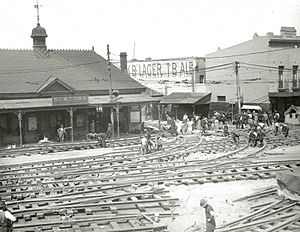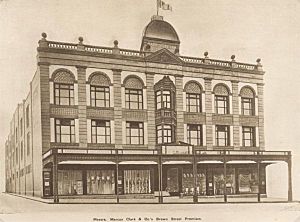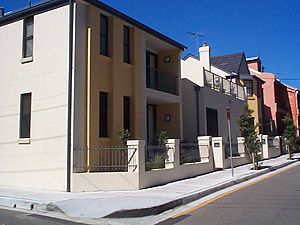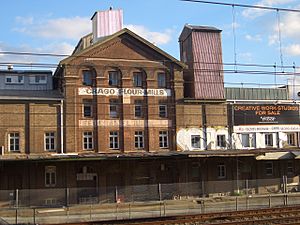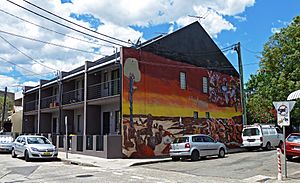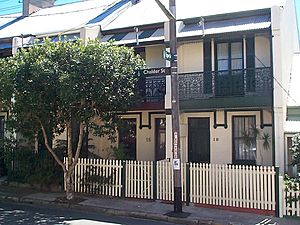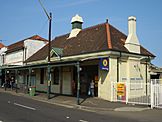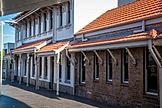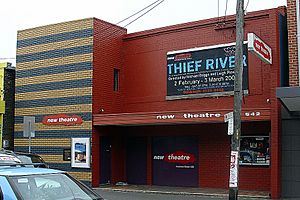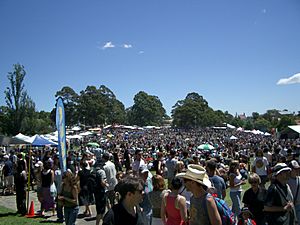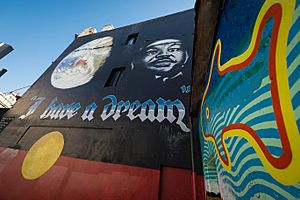Newtown, New South Wales facts for kids
Quick facts for kids NewtownSydney, New South Wales |
|||||||||||||||
|---|---|---|---|---|---|---|---|---|---|---|---|---|---|---|---|
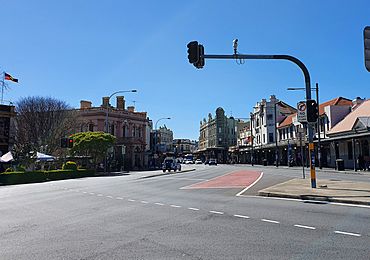
Intersection of King Street & Enmore Road, Newtown
|
|||||||||||||||
| Population | 15,029 (2016 census) | ||||||||||||||
| • Density | 9,390/km2 (24,300/sq mi) | ||||||||||||||
| Established | 1812 | ||||||||||||||
| Postcode(s) | 2042 | ||||||||||||||
| Elevation | 42 m (138 ft) | ||||||||||||||
| Area | 1.6 km2 (0.6 sq mi) | ||||||||||||||
| Location | 4 km (2 mi) south-west of Sydney CBD | ||||||||||||||
| LGA(s) |
|
||||||||||||||
| State electorate(s) | Newtown | ||||||||||||||
| Federal Division(s) | |||||||||||||||
|
|||||||||||||||
Newtown, a suburb of Sydney's inner west, is located approximately four kilometres south-west of the Sydney central business district, straddling the local government areas of the City of Sydney and Inner West Council in the state of New South Wales, Australia.
King Street is the main street of Newtown and centre of commercial and entertainment activity. The street follows the spine of a long ridge that rises up near Sydney University and extends to the south, becoming the Princes Highway at its southern end.
Enmore Road branches off King Street towards the suburb of Enmore at Newtown Bridge, where the road passes over the railway line at Newtown Station. Enmore Road and King Street together comprise 9.1 kilometres of over 600 shopfronts. The main shopping strip of Newtown is the longest and most complete commercial precinct of the late Victorian and Federation period in Australia. King Street is often referred to as "Eat Street" in the media due to the large number of cafés, pubs and restaurants of various cultures. Cafés, restaurants and galleries can also be found in the streets surrounding King Street.
Newtown's rugby league club competed in the NSWRFL Premiership from its foundation in 1908 until 1983.
History
Aboriginal history
The area we now know as Newtown was part of a broader area where Cadigal tribe of the Eora people, who ranged across the entire area from the southern shores of Sydney Harbour to Botany Bay in the south-east and Petersham in the inner-west.
The first Aboriginal Australian to receive a Christian burial was Tommy, an 11-year-old boy who died of bronchitis in the Sydney Infirmary. He was buried in Camperdown Cemetery, in a section now located outside the wall. The cemetery also contains a sandstone obelisk erected in 1944 by the Rangers League of NSW, in memory of Tommy and three other Aboriginal Australians buried there - Mogo, William Perry and Wandelina Cabrorigirel, although their graves are no longer identifiable. When the names were transcribed from the records onto the monument, there was an error in deciphering the flowing hand in which many of the original burial dockets were written. It is now known that the fourth name was not Wandelina Cabrorigirel, but Mandelina (Aboriginal)
King street, Newtown's main street, reputedly follows an Aboriginal track that branched out from the main western track, now beneath Broadway and Parramatta Road, and which continued all the way to the coastal plains around Botany Bay. This conflicts with other claims that the main western track was a barrier which divided the land.
19th century
Newtown was established as a residential and farming area in the early 19th century. The area took its name from a grocery store opened there by John and Margaret Webster in 1832, at a site close to where the Newtown railway station stands today. They placed a sign atop their store that read "New Town Stores". The name New Town was adopted, at first unofficially, with the space disappearing to form the name Newtown.
The part of Newtown lying south of King Street was a portion of the two estates granted by Governor Arthur Phillip to the Superintendent of Convicts, Nicholas Devine, in 1794 and 1799. Erskineville and much of MacDonaldtown were also once part of Devine's grant. In 1827, when Devine was aged about 90, this land was acquired from him by a convict, Bernard Rochford, who sold it to many of Sydney's wealthiest and most influential inhabitants including the mayor. Devine's heir, John Devine, a coachbuilder of Birmingham, challenged the will, which was blatantly fraudulent. The "Newtown Ejectment Case" was eventually settled out of court by the payment to Devine of an unknown sum of money said to have been "considerable". The land was further divided into the housing that is now evidenced by the rows of terrace houses and commercial and industrial premises.
Part of the area now falling within the present boundaries of Newtown, north of King Street, was originally part of Camperdown. This area was named by Governor William Bligh who received it as a land grant in 1806 and who passed it to his daughter and son-in-law on his return to England in 1810. In 1848 part of this land was acquired by the Sydney Church of England Cemetery Company to create a general cemetery beyond the boundary of the City of Sydney. Camperdown Cemetery, just one block away from King Street, Newtown, was to become significant in the life of the suburb. Between its consecration in 1849 and its closure to further sales in 1868 it saw 15,000 burials of people from all over Sydney. Of that number, approximately half were paupers buried in unmarked and often communal graves, sometimes as many as 12 in a day during a measles epidemic. Camperdown Cemetery remains, though much reduced in size, as a rare example of mid-19th-century cemetery landscaping. It retains the Cemetery Lodge and huge fig tree dating from 1848, as well as a number of oak trees of the same date. It survived to become the main green space of Newtown. Among the notables buried in the cemetery are explorer-surveyor Sir Thomas Livingstone Mitchell, Major Edmund Lockyer and Mary, Lady Jamison (widow of the colonial pioneer landowner, physician, constitutional reformer and 'knight of the realm', Sir John Jamison). The cemetery also holds the remains of many of the victims of the wreck of the Dunbar in 1857.
From 1845, when the first Anglican church was built on the site of the present Community Centre on Stephen Street, by Edmund Blacket, a number of churches were established, including St Joseph's Roman Catholic Church in the 1850s, the Methodist Church on King Street, now Newtown Mission, and the Baptist Church in Church Street. The present St Stephen's Anglican Church, a fine example of Victorian Gothic architecture, was designed, like its predecessor, by Blacket, and built in the grounds of cemetery between 1871 and 1880. Both it and the cemetery are on the National Trust register of buildings of National Significance. Its Mears and Stainbank carillon is unique in Australia, while its Walker and Sons organ of 1874 is regarded as one of the finest in New South Wales.
On 12 December 1862 the Municipality of Newtown was incorporated and divided into three wards: O'Connell, Kingston and Enmore, covering 480 acres (194.25 ha). In 1893 a plan was discussed to rename the council area 'South Sydney' (as two municipalities North of Port Jackson (Sydney Harbour) had merged to form North Sydney three years earlier), but nothing came of it.
Housing
Although there are a few earlier buildings in Newtown, the most rapid development came in the late 19th century , with many former farms and other large properties being subdivided and developed as row-houses, known popularly as "terrace houses". With their predominance of Victorian-era houses with stuccoed facades, balconies of iron lace and moulded architectural ornaments, many Newtown streets are similar to those of other well-known inner-city suburbs like Glebe, Paddington and Balmain.
From about 1870 onwards, Newtown had a large proportion of its residents living in terrace houses of the cheapest possible construction, much of which was "two-up two-down", with rear kitchen, some having adjoining walls only one brick thick and a continuous shared roofspace. Hundreds of these terrace houses still remain, generally 4 metres (13 ft) wide. It was not uncommon for speculative builders to build a row of these small houses terminating in a house of 1½ width at the corner of the street, this last being a commercial premises, or "Corner Store". During the Federation period, single storey row houses became increasing common.
This preponderance of small houses is indicative of the working-class employment of most of the Newtown residents, many of whom worked in the city or at local shops, factories, warehouses, brickyards and at the nearby Eveleigh Railway Workshops. Retail and service trades dominated the suburb increasingly throughout this period, with tradesmen and shopkeepers together accounting for 70-75% of the working population. During the late 19th century and early 20th century, Newtown prospered, so much so that in the Jubilee Souvenir of the Municipality of Newtown, published in 1912, it was described as "... one of the most wealthy suburbs around Sydney."
A number of imposing Victorian mansions were also built on larger estates, as well as rows of larger and more stylish terrace houses in certain areas such as Brown Street in North Newtown, and Holmwood Street in South Newtown. As in many other historic areas of Sydney, some of the largest and most important houses, such as 'Erskine Villa' (formerly on Erskineville Road, and which gave its name to the suburb of Erskineville), were demolished and the estates subdivided. Another loss was the home of Mary Reibey in Station Street, which was acquired by the NSW Department of Housing in 1964, demolished in 1967, and replaced by a public housing apartment block. Only the cottage of Reibey's dairyman survives, a little further down the street.
One of the most impressive surviving sets of 19th-century housing in Newtown is the imposing terrace of five elegant five-storey mansions running along Warren Ball Avenue in North Newtown, facing onto Hollis Park.
From the late 19th century onwards, the Newtown area became a major commercial and industrial centre. King Street developed into a thriving retail precinct and the Newtown area was soon dotted with factories, workshops, warehouses and commercial and retail premises of all kinds and sizes. Several major industries were established in the greater Newtown area from the late 19th century, including the Eveleigh rail workshops, the IXL jam and preserves factory in North Newtown/Darlington, the St Peters brickworks and the Fowler Potteries in Camperdown.
Early 20th century
Although it prospered in the late 19th century, during the first half of the 20th century, and especially during The Depression, like many inner-city Sydney suburbs such as Glebe and Paddington, the area became increasingly run down as wealthy Sydneysiders preferred to settle in newer and more prestigious areas. In 1949, Newtown was incorporated into the City of Sydney.
Mid-20th century
Newtown was originally a relatively prosperous suburb, the legacy of which is the numerous lavish Victorian mansions still standing in the area. However, many parts of Newtown had gradually become a working-class enclave, and for much of the 20th century, Newtown was a low-income blue-collar suburb, often denigrated as a slum. In the post-war period, the low rents and house prices attracted newly arrived European migrants, and Newtown's population changed radically, becoming home to a sizeable migrant community.
In 1968, a controversial redistribution of local government boundaries by the Askin State Liberal government saw part of Newtown become part of Marrickville Council. From the 1970s, as the post-war population prospered, raised families and aged, many moved to outlying suburbs to build larger houses, resulting in a supply of relatively cheap terrace houses and cottages entered the rental market. Because of its proximity to the expanding Sydney University and the Sydney CBD, along with the comparatively low rents, Newtown began to attract university students in the 1960s and '70s. The area became a centre for student share-households in Sydney and the development of cafes, pubs and restaurants made it a mecca for many young people. Newtown gained a reputation as a bohemian centre and the gay and lesbian population also increased.
Late 20th century and early 21st century
The 1980s was the period that probably saw the greatest diversity in Newtown. At this time, cheap housing was still available. During the 1990s many long-established businesses closed, including Brennan's Department Store, a charming old-fashioned department store founded in the 19th century, and one of the last relics of the heyday of Victorian commerce in Newtown.
Many homes have been restored and remain examples of 19th-century architecture in Sydney. The northern end of Newtown (closer to the University and the city) is considered the more prestigious, with house prices and rents in this part of town often higher than those for similar properties in South Newtown, Enmore or St Peters. Like other similar inner-Sydney suburbs (most notably Paddington and Glebe), gentrification has led to another shift in Newtown's demographics. From the 1970s onwards, many major industrial and commercial sites in the area were closed or vacated. Many of these former commercial sites have since been redeveloped as housing such as the Alpha House and Beta House apartment complexes on King Street, which were formerly both multi-storey warehouses. Prior to becoming apartments, Alpha and Beta house became two artist warehouses that accommodated the birthing of many national and international performing arts companies and artists. One such company, 'Legs on the Wall' www.legsonthewall.com.au, was created in Beta House at the suggestion of Kerry Dwyer (original director), while Brian Keogh (original member/producer) had his leg on the old window surrounds stretching as part of the daily ritual.
One of the most significant and visible changes to the area has been the redevelopment of the Silo apartment complex, designed by, which occupies part of Crago Flour Mills and former grain silos, which had been built on the site of the original Newtown station, at the end of Station Street. Rather than demolishing the silos and building a new structure, the developers reconstructed the building and created a series of circular apartment spaces, augmented by the construction of more traditionally shaped apartments on the lower levels.
In 2014, British alternative rock band Coldplay featured the town in the Music video for their new single, 'A Sky Full Of Stars'.
Transport
Rail
Newtown railway station is on the Inner West & Leppington Line of the Sydney Trains network. The station opened in 1855, as one of the original four intermediate stations on the Sydney to Parramatta railway line (the others being Ashfield, Burwood and Homebush), and it was soon serviced by ten steam trains a day. In 1878 the station was moved from Station Street to its current location by the fork of King Street and Enmore Road.
Until the 1960s, when trams were phased out in Sydney, Newtown was a major hub for train-tram transfers; several regular electric tram services were centred there and the old Newtown Tram Depot (long vacant and now largely derelict) still stands next to the station. A small building (next-door to the Bank Hotel) operated as a late-night kebab and takeaway food outlet for many years from the late 1960s until it closed in the mid-1980s and the building was later demolished. The long-abandoned former office buildings of the tram depot (adjacent to the current station entrance) were renovated during the renovation and rebuilding of Newtown Station and how house a café and restaurant. This extensive renovation, completed in 2012, greatly improved commuter access to the station platforms (which lie in a deep cutting under King St) including additional stairways and a disabled-accessible elevator, although the renovation works and the layout of the new station entrance blocked the old tram-line entry way into the tram sheds, effectively cutting off direct vehicular access from King St into the tram sheds (which still lie vacant and derelict as of mid-2017).
Buses
Transdev John Holland and Transit Systems operate buses through Newtown. The trams were replaced by bus services that inherited the old route numbers – 422, 426, 428 – and follow the old tram routes that run along King Street and Enmore Road, going inwards to the city and outwards to Tempe, Dulwich Hill and Canterbury, respectively. Since then the 423 service from the city to Kingsgrove Bus Depot via Newtown has been added. There is also the 352 service that goes east through Surry Hills to Bondi Junction and the 370 service running north to the University of Sydney and Glebe Point and south-east to the University of New South Wales and Coogee.
Landmarks
Pubs
In part because of its industrial and commercial history, the Newtown area contains many pubs. These include a number of late-Victorian establishments and several in an Art Deco style from the mid-20th century. In July 2000, one of these, "The Marlborough", called by historian Chrys Meader "the Gateway to Newtown" because of its visually commanding appearance at a wide intersection of King Street and Missenden Road, was stripped of all its original Art Deco tiles and had its upper floor substantially damaged before protests to the council prevented this being taken further.
The Trocadero
One of the major architectural conservation projects in Newtown in recent years has been the restoration of the Trocadero dance hall in King Street North. This large entertainment venue opened in 1889 and is one of the last 19th-century dance halls still standing in Sydney. Over the years it functioned variously as a dance hall, a skating rink, a cinema, a boxing and vaudeville venue, a bicycle factory and a motor body works.
From 1920 onward it was owned by the Grace Brothers retail company, and several sections were leased out as shops or accommodation. For many years the shopfront on the northern side of the building housed Maurice's Lebanese Restaurant, commemorated in John Kennedy's "On King St, I'm A King". The building was purchased by Moore Theological College in 1974, and from 1981 to 1994 it housed the Con Dellis used furniture store, but all occupation ceased after that time. Fortunately, a sympathetic restoration program during 2005–06 by Moore College has returned this outstanding 19th-century building, including its elaborate Flemish-style facade, to its former glory.
Burland Hall
One Newtown landmark that has undergone many changes during the 20th century is the site of the former Burland Community Hall, on King St. In the early 20th century the site was occupied by the original Hub Theatre. From the mid-20th century it was occupied by an Art Deco-style cinema operated by the Hoyts cinema chain. In the mid-1960s the cinema was converted into a community hall and it was renamed Burland Community Hall in 1965. For years it was the venue for community events such as dances, concerts, film screenings, meetings, parties, wedding receptions and a community market. In 1986 its upper floor was taken over for the Newtown branch of the City of Sydney Library network, following the decision by Marrickville Council to close its Newtown library branch due to budgetary constraints. In 1995 the library moved to new premises in the former Salvation Army Citadel in nearby Brown Street, and Burland Hall was redeveloped into offices and retail premises.
Hub Theatre
One of the most notable local landmarks is the Hub Theatre opposite Newtown Station, next to the old Newtown Town Hall. The original Hub stood at 222 King St, before moving to its present location, on the site of an earlier vaudeville theatre. It was converted to a cinema in the 1930. Recently, the Hub has been home to live comedy shows and other such performances, seeing a rejuvenation of the building.
Culture
Live music
Newtown has been a hub for live entertainment since the late 19th century. During the 1980s the many pubs in the area housed a thriving live music scene, notably the The Sandringham in King Street.
Throughout the 1990s it was particularly known as a centre for indie rock, with the suburb home to many musicians and several live venues. In the late nineties it boasted a handful of popular venues: Goldmans / Newtown RSL, The Globe, Feedback and The Sandringham, all of which had closed by the late 1990s. After its takeover by Petersham RSL Club, the former Newtown RSL reopened as a music venue under the name of @Newtown but closed in January 2011 due to financial losses.
In recent years, the suburb has enjoyed a renaissance with the return of live music to The Sandringham (dubbed by regulars as "The Sando") after the pub's upper floor was rebuilt as a performance room, and small ensembles and bands still perform in the front bar. Another recent addition to Newtown's live music scene is the small live venue The Vanguard at the north end of King Street, and the continuing popularity of the lyric-sized Enmore Theatre.
Theatre
Newtown and its surrounding areas have the highest concentration of independent theatres and live performance spaces in Sydney. Theatres include:
- New Theatre, formed in 1932 and is Australia's oldest continuously performing theatre.
- Enmore Theatre on Enmore Road
- the Newtown High School of the Performing Arts
In the 1970s and '80s many theatres, cinemas and music venues in the Sydney CBD were demolished. Due to the lack of "lyric"-sized venues, the Enmore Theatre in Enmore Road has become one of the busiest medium-sized concert venues in Sydney.
Festivals
Newtown hosts a number of annual festivals.
The Newtown Festival is a community festival of free live music, events, workshops and stalls that has been held annually since 1978.
Held in Camperdown Memorial Park next to St. Stephen's Church, Newtown. The purpose of the festival is to raise funds for the Newtown Neighbourhood Centre, an association that provides services to non-English speakers, the aged, disabled or poor. Controversially, in 2006 for the first time the festival was held within a fenced confine.
Feastability, Newtown's Food and Wine Festival, showcases the eclectic international cuisines of the suburb along with Australian wine, local pubs and brewers, bakers and confectioners. The festival, which is held on the last Sunday of each September, started in the mid-1990s as six stalls outside the Hub. It now takes place in the grounds of Newtown School of Performing Arts, has more than 40 stalls and features all-day entertainment from musicians and artists, as well as kids' activities. The festival is organised by Marrickville Council.
Under the Blue Moon Festival is an alternative community festival also held in September. The event has a variety of entertainment; live music, discussions, street performances, fashion shows and other subculture presentations, especially those of the Goth community. Local business and special interest groups provide a diverse variety of entertainment, including a local alternative hairdresser and even the local mortuary with a display of coffins.
The Sydney Fringe festival is a three-week alternative arts festival that was held for the first time in September 2010 at venues in Newtown, Enmore and Marrickville. It is a project of the Newtown Entertainment Precinct Association.
Sport
Newtown Rugby League Club—the "Newtown Jets"—is Australia's oldest existing rugby league club, formed in 1908 at the Newtown Town Hall. They compete in the NSWRL Premier League competition, a tier below the NRL's national premiership, having left the top grade after the 1983 season. Their home ground is Henson Park, Marrickville.
Film and television
In the late 1960s, the Australian TV drama series You Can't See Round Corners starred Rowena Wallace and Ken Shorter as a draft dodger hiding out in Newtown.
In the mid-1980s, the Spanish Mission-style service station on King Street was used as a location for scenes in the Ray Lawrence film Bliss, which was based on the novel by Peter Carey. In the film, the service station was used as the childhood home of Harry Joy's wife Bettina, played by Lynette Curran.
Garage Days directed by Alex Proyas, depicts a fictional indie rock band based in Newtown, and Erskineville Kings, starring Hugh Jackman, features extensive use of locations in Newtown and Erskineville.
The ABC television drama Love Is a Four Letter Word, starring musician-actor Peter Fenton and featuring live bands each episode, included extensive location shooting at the Courthouse Hotel in Australia Street.
St Stephen's Church and Camperdown Cemetery have regularly been used as sites for filming movies, TV and videos, notably in Priscilla, Queen of the Desert.
Graffiti and street art
The Newtown area is also known for its creative graffiti and "street art". The most prominent of these works are the large murals created in the late 1980s and early 1990s, which were painted on the walls of houses and shops in the area. Spray-painted "tags" have proliferated all over the area in recent years, although more recently the style of tagging has become far more elaborate than the simple spray-can signatures that litter walls throughout the district.
Examples include a mural of American civil rights leader Martin Luther King Jr. on King Street (painted by Andrew Aiken (Seems)and Juilee Pryor), the "Great Wave" mural in Gowrie Street, the "Three Proud People" mural (a reproduction of a photo taken at the 1968 Mexico City Olympics), and the "map of Africa" mural in King Street.
Gay and lesbian culture
Newtown, St Peters and Erskineville have the highest proportions of same-sex couples in the 2011 census. The gay and lesbian community of Newtown also extends into neighbouring Glebe, Leichhardt, Annandale, Marrickville, Enmore and Dulwich Hill.
Population
Demographics
In the 2011 Australian Bureau of Statistics Census of Population and Housing, the population of the Newtown postcode area was 14,148 people, in an area of 1.9 square kilometres. 40% of the population was born overseas: 5.5% England, 3.4% New Zealand, 1.4% the United States of America, and 1.2% China (excludes SARs and Taiwan). The five strongest religious affiliations in the area were in descending order: No religion 44.2% (National average 22.3%), Catholic 16.4% (25.3%), Anglican 9.5% (17.1), Buddhism 3.9%2.5%), Eastern Orthodox Christian 3.4% (2.6%). The three most common forms of dwelling were in decreasing order: a semi-detached, row or terrace house, or townhouse; a flat, unit or apartment; a separate house. After English the five most commonly spoken languages are Greek, Mandarin, Cantonese, Spanish and Thai.
Notable residents
- Angelspit, industrial music duo
- Christine Anu, pop singer
- Charles Badham (1813-1884), classical scholar
- Sarah Blasko, musician
- Rolf Boldrewood (1826–1915), born Thomas Browne, author of seventeen novels including the classic Robbery Under Arms
- Doc Brown, comedian former rapper
- Arthur Capell (1906-1982), linguist & anthropologist
- Murray Cook, member of Australian children's group The Wiggles
- John Villiers Farrow (1904–1963), Academy Award winning Australian film director and father of actresses Mia Farrow and Prudence Farrow
- Francis Forbes (1784-1841), first Chief Justice of the NSW Supreme Court
- Lilian Fowler (1886-1954), Labor politician, Australia's first female Mayor
- Frenzal Rhomb, band originating in Newtown
- Nicholas Harding, former winner of the Archibald Prize for portraiture
- Ignatius Jones, entertainer and former lead singer of 80s rock band Jimmy And The Boys
- Henry Kendall (1831-1882), poet
- Ruby Langford Ginibi (1934-2011), Bundjalung author and Koori activist
- Henry Lawson (1867-1922), writer
- Genevieve Lemon, actress and singer
- Paul Mac, DJ and music producer
- Enda Markey, theatre producer
- Dawn O'Donnell (1928–2007), prominent business and nightclub owner, gay and lesbian rights campaigner
- Mary Reibey (1777–1855), pioneering entrepreneur who is portrayed on the Australian twenty-dollar note
- Saul Samuel (1820-1900), merchant and politician
- Adam Spencer, mathematician, science broadcaster and radio and TV personality
- Bertram Stevens (1872-1922), literary critic, art critic, editor
- Monica Trapaga, former children's presenter and jazz singer
- Nadia Wheatley, writer
- The Whitlams, pop band
- Charles Windeyer (1780-1855), magistrate & legal pioneer, inaugural Lord Mayor of Sydney
- Harold Wyndham (1903-1988), educationalist
- Youth Group, indie rock band mostly known for their hit remake of "Forever Young"
Gallery
Education
In the 1990s, Newtown High School was chosen by the NSW Department of Education as the site for a new specialised performing arts high school, which would combine traditional academic subjects with music and theatrical performance education. The school was renamed Newtown High School of the Performing Arts. Prior to becoming Newtown High School, it was Newtown Junior Technical School (the "tech") that educated boys from 1st Year to 3rd Year at the end of which they gained the Intermediate Certificate unless they had already left school at the age of 15. Girls of the same age group were educated in the southern part of Newtown Public School. The primary public school was segregated with the boys part facing Newman St opposite the tannery works that often omitted obnoxious odours.' (From "Prior to...odours" it is based on personal knowledge through living in Newtown and attending those schools.)
Primary and infants school include:
- Australia Street Infants School
- Bridge Road School, Camperdown
- Camdenville Public School
- Newtown Public School
- North Newtown Public School
- St Joseph's College (defunct)
Private schools in the area include the Athena School.
The University of Sydney's Centre for Continuing Education provides adult education open to the general public.
Images for kids



